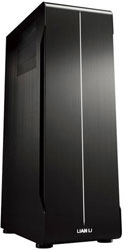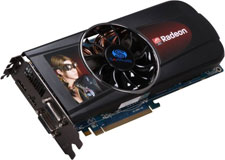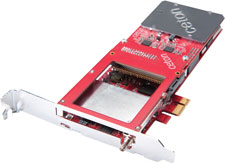Holiday 2010 System Builder's Guide
by AnandTech Staff, edited by Jarred Walton on November 19, 2010 2:00 AM EST- Posted in
- Guides
- Systems
- Holiday 2010
Alan's Ultimate HTPC: Bringing Total Entertainment to the Living Room
Our final build is for those of you who do not like to compromise with your HTPC. Are you tired of hooking up multiple streaming boxes to get all your internet content, NAS for secondary streamers, and another gaming system as well? There are numerous users out there, myself included, that love HTPC as well as gaming. There are many ways to skin the proverbial HTPC cat; this guide is for those of you who want it all in one box on your big screen. There will be sacrifices however, and those come in the size department and in the old pocket book. If you're looking for a small, quiet HTPC that isn't as powerful but doesn't cost an arm and a leg, go look at what Ganesh is pushing.
| Alan's Ultimate HTPC | ||
| Hardware | Component | Price |
| Processor |
Phenom II X6 1090T Black Edition (Thuban 45nm, 3.2GHz, 6x512K L2, 6MB L3, 125W) |
$210 |
| CPU HSF | Noctua NH-D14 | $75 |
| Motherboard | MSI 890FXA-GD70 (AMD 890FX AM3) | $200 |
| Video | Sapphire Radeon HD 5870 1GB (100281-3SR) | $300 |
| GPU HSF | Arctic Cooling Accelero Xtreme | $57 |
| TV Tuner | Ceton InfiniTV4 CableCARD Quad-Tuner | $400 |
| Memory |
G.Skill Ripjaws 2x4GB DDR3-1600 CL9 (F3-12800CL9D-8GBRL) |
$150 |
| OS Drive (SSD) | OCZ Vertex 2 120GB ($20 MIR) | $210 |
| Misc | Icy Dock MB882SP-1S-1B | $20 |
| Hard Drives | 3 x Western Digital Green 2TB (WD20EARS) | $300 |
| Optical Drive | LG UH10LS20 Blu-ray Combo Drive | $85 |
| Case | Lian Li PC-X2000F | $300 |
| Power Supply | Seasonic SS-560KM 560W (80 Plus Gold) ($15 MIR) | $115 |
| Mouse | Razer Mamba | $110 |
| Keyboard | Logitech diNovo Edge | $157 |
| Software | Windows 7 Professional 64-bit (OEM) | $135 |
| Software | Hipporemote Pro | $5 |
| Software | PowerDVD 10 Ultra | $90 |
| Misc | Powermat for iPhone 3GS (PMM-1PB-B2A) | $41 |
| Total System Price | $3015 | |

The first thing to look at for an HTPC is the case, and the most important feature in the case of an HTPC is noise. This is the major problem with multipurpose machines. Gaming cases tend to stay cool but also tend to be noisy and filled with enough LEDs to be mistaken for a flight beacon; after all gamers tend to want to highlight all their high-end hardware. Finding components that will both be cool enough for gaming and quiet enough for a home theater is the key here. A great best of both worlds case is the Lian Li PC-X2000F. At $299 from Newegg as of this writing, the case is pricey, but it currently sports a $200 saving (though that may disappear soon). At that price, I think it is an excellent buy for a home theater/gaming enthusiast.
New to this version is USB 3.0 support and a redesigned case layout. With five 140mm fans, dust filters, and anti vibration solutions, the air-cooling is both highly effective and extremely quiet. Sporting seven HDD bays with the installed back plates for hot-swappable fun, this case has plenty of room for media drives; just make sure your motherboard or RAID card have enough SATA connectors.
Speaking of storage, currently 2TB WD20EARS drives are shipping for $100 and are a great way to expand your media storage capabilities and tend to run on the quiet side of things—no need for a NAS when your HTPC case holds enough traditional HDDs to feed every other device in your home with media! The case is limited to 3.5" drives, but throwing your favorite SSD into an Icy Dock or similar device will allow you to push it right into one of the HDD back plates to get your OS and applications loading at high speed with no noise whatsoever.

For the GPU, I chose AMD because of the bitstreaming support for HD audio codecs. We can argue about performance with the 5870 and 6870, but the 5870 has been around enough that aftermarket cooling solutions are readily available. Add a Noctua cooler to your favorite CPU as well as an Arctic Cooler Accelero on your high-end AMD graphics card for cool and quiet gaming that won't leave you straining to hear during quiet movie scenes. We've also selected a high-efficiency, near-silent 560W power supply from Seasonic to keep everything running; the GPU + CPU combination generally means we need more power than a typical HTPC, but since this is the main feature of the Home Theater/Gaming we went higher end.
At this point, we've taken your NAS or Windows Home Server, HTPC, and gaming PC and combined them into one glorious entertainment system. You'll need help accessing all that media however. Free applications like Boxee and My Movies 3 can help sort local and internet content past what Windows Media Center offers, but pay applications like PowerDVD will integrate well with Media Center and will also play nice with My Movies adding Blu-ray capability into the mix. But there's still more….
The smartphone is one of the best ways I have found to control a Windows-based HTPC. With HippoRemote on your phone and HippoVNC booting on your PC, you can use your smartphone to seamlessly open Windows Media Center, Boxee, Hulu, or myriad other applications. The touchscreen on the phone then transforms into a remote interface designed for the application of your choice. It is a great way to navigate seamlessly between applications that bring you internet or media content without having to browse endless webpages, and there's no need to hack Media Center. The problem is, using your smartphone in this manner depletes the battery at a rapid rate; that's why adding a Powermat on the coffee table will address this problem and charge your smartphone/remote each time you set it down. You'll still want a good wireless mouse as well as a keyboard for gaming. I like the Razer Mamba mouse, while the Logitech Dinovo Mini or Edge are excellent options for the keyboard.

Last but not least, you can add cable TV into your HTPC with a Ceton InfiniTV 4 CableCARD tuner. Although quite expensive and backordered, they bring four simultaneous HD streams into your PC through a single card. Streams can be accessed in other rooms via the Xbox 360, or by adding a network bridge to the tuners (a process still in beta firmware, but it should be available by the time the cards are out of backorder). Or, if you're one of those looking to cut the cable, save $400 and stick with streaming video.
You can see my list of components up top, but play around with what works best for you. I went with an AMD setup to keep the cost slightly lower and chose a single GPU as the system will likely be hooked to an HDTV that will limit the resolution for gaming to 1920x1080. Sadly, the single most expensive item is the CableCARD tuner. But for around $3000, you'll be ripping Blu-rays onto 6TB of storage, controlling your media with your phone, and playing the latest games on your 1080p TV. Enjoy!










112 Comments
View All Comments
DanNeely - Friday, November 19, 2010 - link
I've always put my faith in the low score reviews than the high ones because people are morel likely to complain about bad parts than to write good reviews. You definitely do need to read the actual reviews and filter the idiots out first though.Brian Klug - Friday, November 19, 2010 - link
I'm glad someone caught me on the Xeon coolers - I usually forget that the boxed Xeons don't come with a cooling solution up until right as I start building, then run to the store and grab something.Honestly, everyone has their own LGA 1366/Socket B choice it seems. I went with one cooler one time that was too big for my Cosmos S case (the door wouldn't close), and hesitated to recommend something given that I haven't actually *seen* the SR-2 in the flesh. I wager one of those Zalmans that's flat (with the fan normal to the motherboard) probably makes most sense/has best chances of actually fitting.
Awesome comments ;) I wish I could build that thing, honestly!
-Brian
rootheday - Friday, November 19, 2010 - link
Interesting that the Intel budget system comes out >$120 higher than the AMD system... but most of that difference because of the choice to include a discrete GPU and BluRay drive in the Intel system. If you leveled that out (and chose same power supply/case) the Apples-to-apples comparison comes out much closer - down to a $40 difference (~10%).For that difference you get a tradeoff between slightly faster 3D graphics in the AMD 4250 (but neither will do much beyond casual gaming) vs Intel CPU that is faster in the case in most workloads and signficantly lower idle power. Both can handle media and normal browsing, photo editing, email, and productivity apps with ease.
JarredWalton - Friday, November 19, 2010 - link
Which is what we say at the bottom of the Intel page:"If you like comparisons, while some of the features are clearly different (i.e. Blu-ray, case, etc.), this Intel setup checks in at $40 more than our AMD build looking just at the motherboard and processor. It's true that Intel has plenty of less expensive processors, but rather than pitting Pentium G6950 against the Athlon II X4 645 we decided to go with the more capable i3-550. AMD's budget parts easily win in multi-threaded tests, but the Core 2010 architecture does very well in other areas. In other words, neither choice is always "right" but instead you need to decide what tasks are most important for your workload."
wwswimming - Friday, November 19, 2010 - link
This system is adequate for watching the Pipe Masters.Can I have it when you're done with it ?
Conficio - Friday, November 19, 2010 - link
I'm surprised with all the dream machines, that non of you went for one of the Multi Monitor setups.What is the hold back?
I'd think that is way more attractive for home use than a 24 GB 12 core XEON system, that is waisting more than half of its power and money going unused 95% of the time in any personal home use.
Really I'd like to hear why that does not seem to be on the wish list of any of you?
bji - Friday, November 19, 2010 - link
I can't see the point of multi monitor setups except when each monitor is used as a discrete desktop with no windows split across them. Setups where games split across monitors seem like the biggest joke to me. Who wants to play a game with a grid of bezels splashed across it? I can't believe that anyone even attempts such ridiculous setups or that these are featured by graphics card makers (AMD Eyefinity).Given that, I don't see too much point in multi-monitor setups for home use, when larger LCD panels (24 inches and above) give so much desktop real estate already.
geniekid - Friday, November 19, 2010 - link
1) I would love to see Brian's dream machine built and benchmarked.2) Does the MSI 890FXA-GD70 for Alan's HTPC support Dolby Digital Live/DTS Connect? If so, I assume the intention is to use SPDIF to send the digital audio to the receiver? Otherwise I'm surprised at the lack of a sound card.
3DoubleD - Friday, November 19, 2010 - link
To answer your 2nd question. Nearly every motherboard sold today supports DD and DTS over SPDIF. Even Windows Vista/7 drivers include support for this (along with 2ch LPCM support for other Windows sounds). So if a motherboard has SPDIF support (optical or coaxial), you have DD and DTS bit-streaming support guaranteed.ajlueke - Friday, November 19, 2010 - link
in response to 2). The idea as far as sound goes is to used the HDMI connection from the 5870 for sound. The AMD graphics cards have on board sound, as well as support for DTS-Master and TrueHD bitstreaming, no seperate soundcard required. I have found that multichannel support over the ATI cards for games is also very good, really makes Starcraft II come alive.